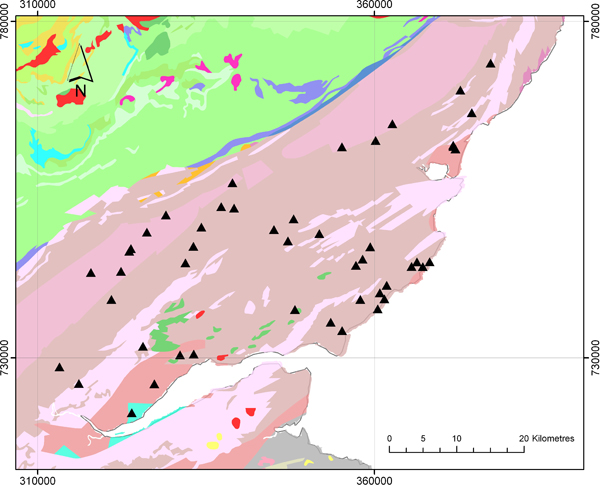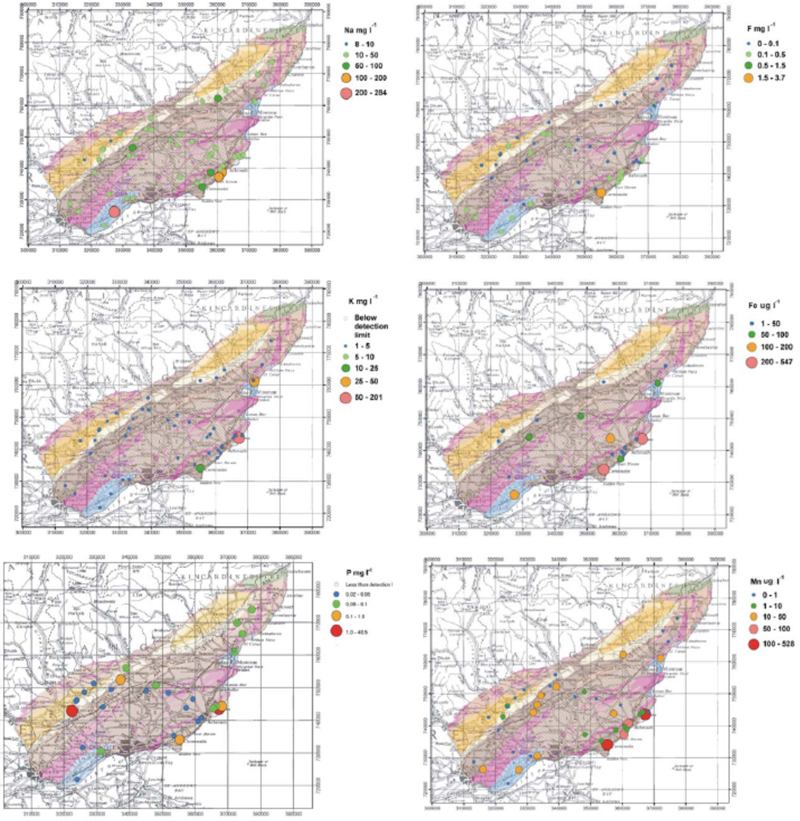A total of 48 groundwater samples, collected from boreholes, springs and shallow wells, were used to interpret the chemistry of groundwater in the high productivity Devonian sedimentary aquifer.

Coverage of baseline sampling in Strathmore against the 625K geology map of the region. BGS © UKRI.
Main findings
The collection and interpretation of new groundwater chemistry data for the Strathmore area has led to the following conclusions.
Dissolved solids
The groundwaters of the Devonian aquifer in Strathmore are mainly weakly mineralised, with total dissolved solid concentrations mostly less than 400 mg/l. Groundwaters have near-neutral to slightly alkaline pH values and are for the most part oxygenated, with detectable dissolved oxygen and high redox potentials. As a result, dissolved iron, manganese and ammonium (NH4-N) concentrations are usually low. Water from shallow boreholes and springs is often undersaturated with calcite, but in deeper boreholes, reaction with carbonate minerals in the aquifer is more usual and most of these are saturated with respect to calcite.
Nitrate
Nitrate concentrations are often high and nearly one-third of the samples exceeded the EC drinking water limit for nitrate of 11.4 mg/L as NO3-N. Under the oxidising conditions, nitrate is a stable solute species across the aquifer and is found at depths in excess of 100 m.
Phosphorus
Concentrations of phosphoros in groundwater across the aquifer are typically less than 0.1 mg/L. Given the importance of phosphorus in controlling eutrophication in surface water, these concentrations in groundwater may be significant.
Salinity
Increased salinity occurs in groundwater in some near-coastal boreholes, most likely as a result of mixing with sea water.
Trace elements
Most trace elements have low concentrations, in accordance with the neutral pH groundwater conditions. Concentrations of arsenic are relatively high in some groundwaters (up to 8.8 μg/L), though none exceeds the EC maximum permissible value for drinking water of 10 μg/L. Concentrations of uranium reach up to 15.4 μg/L, with the highest concentration just exceeding the World Health Organization’s provisional guideline value for drinking water of 15 μg/L. Two other exceedances above maximum permissible values for drinking were observed, for nitrite (highest concentration 0.194 mg/L) and fluoride (highest concentration 3.7 mg/L).
Residence time
The chemistry and residence-time indicators (CFC and stable isotopes) show that the groundwaters are largely of young age, being mostly recharged within the last 40 years, with mixing throughout the top 100 m of the aquifer. The young age of the groundwaters means they are vulnerable to contamination.
Groundwater quality
The most significant groundwater-quality problems identified by this survey are:
- the widespread presence of elevated nitrate concentrations, which is strongly linked to agricultural activity
- elevated phosphate concentrations, which may affect the quality of surface water when discharged to rivers as baseflow
- the presence of saline water in some near-coastal boreholes, indicating localised saline intrusion — it is not clear to what degree the saline intrusion is natural and to what degree it has been enhanced by over-pumping
Summary statistics
The tables provide a statistical summary of the natural variation in groundwater chemistry in each of the studied aquifers in southern Scotland: Silurian, Ordovician, Devonian and Carboniferous. Data between the 10th and 90th percentiles for each element or ion are presented, which allows the influence of outliers to be minimised. We would expect new data to plot within this range 80 per cent of the time.
The data indicates systematic variations in some solutes with geology. Most noticeable is the saturation and supersaturation of calcite in groundwater from Devonian and Carboniferous aquifers and the lack of calcite in many of the samples from the Silurian and Ordovician aquifers. Another difference is the elevation of sulfate and potassium in groundwaters from the Carboniferous aquifer compared to other waters.
Samples from igneous aquifers also have different groundwater chemistries to the main aquifers, but there are too few samples in this group to draw statistically meaningful conclusions about the expected baseline chemistry.
Concentrations in italics in the tables below are below instrumental detection limits and have been estimated using a robust ‘regression on order statistics’ approach. For further detail on this statistical approach, see the full Southern Scotland Baseline report.
Aquifer groundwater chemistry summaries
- Summary statistics of the groundwater chemistry of the Devonian Strathmore aquifer (1 of 2)
- Summary statistics of the groundwater chemistry of the Devonian Strathmore aquifer (2 of 2)
- Piper diagram illustrating the distribution of groundwater chemistry data for the Devonian Strathmore aquifer
Maps of regional variation in selected ion concentrations
Full report
You can download the Baseline Scotland: the lower Devonian aquifer of Strathmore report.



